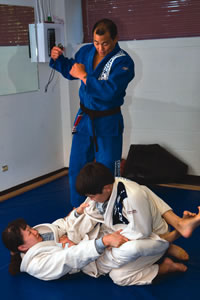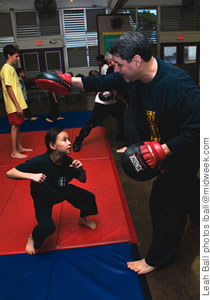The ABCs of MMA
Mixed martial arts is all the rage - sometimes literally. Here’s a brief guide for the uninitiated

|
Apetite middle-school teacher, Cindy Watanabe doesn’t fit most people’s stereotype of someone who trains in mixed martial arts - neither does pastor David Giomi, attorney Jerry Chang, financial adviser Terry Lee nor (I’m guessing) yours truly.
But all of the above - none of whom is a tattooed, aggressive, twentysome-thing male - have trained in mixed martial arts for years.
Mixed martial arts - commonly know as MMA - is said to be the fastest-growing sport in the world. Whether or not that’s true is hard to say, but there is no doubt of its immense popularity. After all, one of the most recent televised events, UFC (Ultimate Fighting Championship) 95, attracted 3 million viewers.
For the uninitiated, the world of MMA can be bewildering. There are more than 50-odd organizations in the sport, from Japan’s Shooto Association to the doomed Elite Xtreme Combat league to the aforementioned UFC, undoubtedly the best known of the lot. Each of these organizations has it own quirks, champions and rules. Elbow strikes may be allowed in one organization, for example, but banned in another.
Then there are the fights themselves. MMA fights tend to incorporate three basic disciplines: striking, clinch and ground.
Striking is just what it sounds like: A fighter tries to punch or kick (and maybe elbow) his or her opponent. Clinch is similar to what happens in boxing when two fighters get tied up, only the fight keeps going, usually with one fighter trying to take the other one to the ground. That’s where things can really get confusing for a newbie. Watching two fighters roll about on the mat throwing punches and trying to trap each other in head or arm locks can easily look like, well, just two people rolling around chaotically, instead of the complicated game of physical chess it is.
To attain proficiency at all three disciplines, mixed martial artists utilize training and techniques from a variety of sources, such as boxing and Muay Thai for striking, judo and wrestling for clinch, and Brazilian jiujitsu for ground. This creates a truly rounded fighter, one who epitomizes Bruce Lee’s dictum “Absorb what is useful.” It also prepares them to defend themselves on the street, and therein lies the appeal for many everyday folks who want to learn MMA.

|
“I specifically was looking for self-defense,” says Cindy Watanabe, who has been training in MMA for 10 years. “I’m 5 foot 1 and 105 pounds. I wanted something practical that didn’t take 20 years to be learned.”
Fifty-two-year-old Terry Lee, president and CEO of Lee Financial Services, was initially drawn to MMA because he “was looking for a good workout,” but also wanted to be able to defend himself. “You have to be prepared in this day and age.”
Both Watanabe and Lee train with Burton Richardson at JKD Unlimited/MMA for the Street, who makes self-defense a “big part” of his curriculum. A longtime veteran of martial arts, Richardson has coached top professional fighters such as Baret Yoshida and Chris Leben, as well as celebrities such as Keanu Reeves and Brandon Lee. It is important to him to be able to maintain an atmosphere in which all sorts of people can safely, effectively learn mixed martial arts.
“In a MMA gym where pro fighters are being trained, you find that everyone spars very hard and takes a lot of abuse,” says Richardson. “People think you either spar hard, or you don’t spar at all ... not a good idea. What I like to do is progressive resistance. You vary intensity based on the person. That way you can train anybody. It doesn’t matter how old they are, or even if they have physical handicaps. Right now, I’m working with someone who is partially paralyzed from a stroke, and the important thing is he still spars.”

|
Former professional fighter Egan Inoue also stresses the universality of mixed martial arts. At his training center, The Studio, he teaches everyone from kids to women to seniors. “We started our seniors program a year ago,” says Inoue. “We now have about 30 enrolled.” He stresses how older people can benefit from MMA training. “Hitting the heavy bag helps fight osteoporosis,” Inoue explains. “Their bone density is much better after hitting and kicking these bags. Also, an important part of MMA training is balance. As you get older, your balance diminishes. This is important for seniors, who if they fall may break a hip. We do lots of pure balance work for seniors.” His school is popular with women, too, as well as many professionals, including “attorneys, doctors and a lot of dentists.” Inoue also teaches children as young as 3 and 4, who learn “skills like rolling, tumbling, foot speed, agility.”
David Giomi teaches children MMA as well. “I have a class for 4-, 5-, 6-year-olds,” he says. “I teach them the basics - how to throw a punch, how to duck, how to do a forward roll, fighting stances. There is a separate class for kids 6 or 7 up to 13 or so. They train in the same things as the adults,” says Giomi, “but I usually don’t teach submissions, arm bars, and chokes to kids under 8 to avoid injury.”
A licensed pastor and worship leader with Hope Chapel, Giomi’s Cornerstone Martial Arts is a bit unusual as it is a Christian MMA school. He doesn’t see anything odd about that at all.
“Martial arts should be about morals, ethics and values,” he says. “Bruce Lee said a martial artist should have a code of honor like a knight. My philosophical paradigm happens to be a Christian one.” His training sessions begin and end with prayers, and kids are given reading assignments relating to Scripture.
Like Richardson and Inoue, David Giomi finds his MMA school attracts a wide variety of people. “My youngest student is 4, my oldest is 58. Many of my students are in their 30s and 40s, and the class is about an even split between men and women.”
From getting a good workout to learning valuable self-defense techniques, mixed martial arts offers something to all sorts of people, young or old, male or female. It does not have to be all about violence and bloodshed. What we see on episodes of The Ultimate Fighter or in a professional fight is only part of what MMA is about. There are many schools and teachers out there looking to do something more than churn out the next UFC champ.
“The environment you learn in is determined by the head of instruction and the actual school,” says Richardson. “You can train safely and have fun if you have the right sort of group. You want a group intent on developing human beings, not just fighters to do battle in a cage. Everyone can have fun and have a great time.”
For information on the MMA schools mentioned in this article, visit www.jkdunlimited.com, www.thestudiohawaii.com and www.cmahawaii.com.
Page 1 of 1 pages for this story
E-mail this story | Print this page | Comments (0) | Archive | RSS
Most Recent Comment(s):








